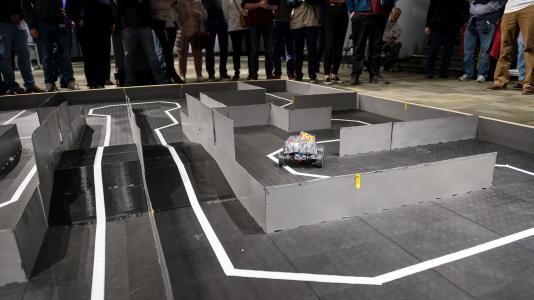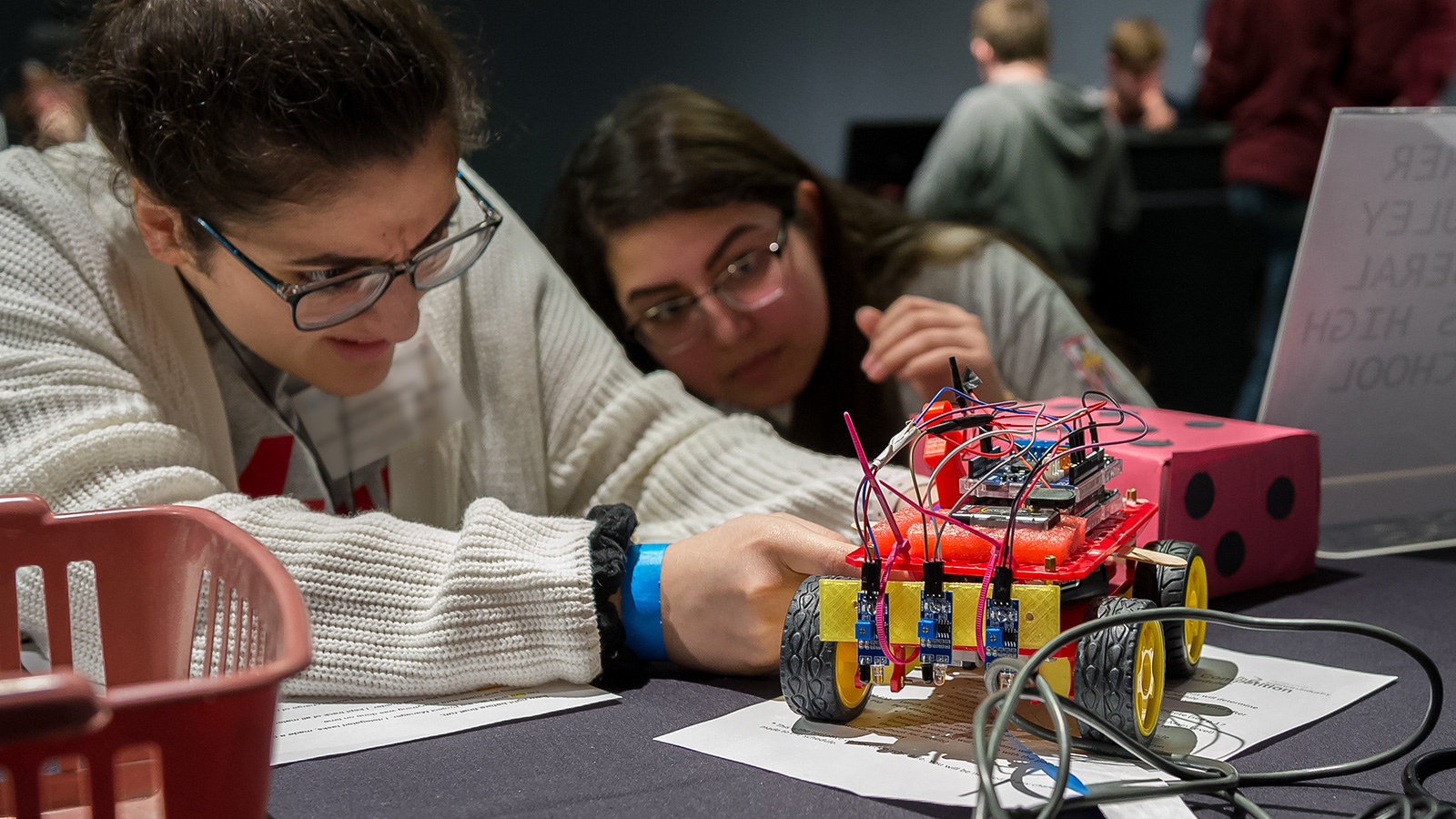
In a large pavilion space on the west end of the Museum of Science and Industry (MSI), high school students gathered in groups at tables along the walls for this year’s Autonomous Vehicle Competition. Each team examined and chatted about the small, wheeled machines in front of them. They anxiously played with the wires, checking if all the systems were working, occasionally groaning when the wheels failed to spin, or shouting “Hey, it works!” when they finally fixed a last-minute problem in the sensors’ response. The atmosphere was tense, and everyone was excited to see how their cars would fare in navigating through this year’s maze-like gauntlet.
The second annual Autonomous Vehicle Competition, developed by Argonne National Laboratory as part of its efforts in STEM (Science, Technology, Engineering, and Math) education, took place at the MSI on April 13th and brought together 10 high school teams from throughout the greater Chicago area. All of the teams had overcome planning and design challenges, and now it was time to showcase their self-guided machines in a test of scientific problem-solving. “Challenges like the AVC provide students the opportunity to see the interdisciplinary nature of STEM, where engineering, computing and physics are all needed to be successful in developing objects like a self-autonomous vehicle,” shared Meridith Bruozas, manager of Educational Programs and Outreach for the Laboratory. “Our researchers work across disciplines, just like the students are doing today, to solve some of our country’s grand challenges.”
In the competition, design matters just as much as performance, and teams must demonstrate how they planned and problem-solved to overcome challenges. Much of the morning was spent in repurposed labs as each team faced a panel of judges and answered questions on the choices they made when brainstorming and creating their machines. For teams that previously competed, past mistakes helped guide their current strategies. Returning to represent Chicago’s Little Village neighborhood, Infinity Math, Science and Technology High School used last year’s team’s challenges to improve their approach. Instead of the ultrasonic sensor system that proved problematic last year, this year’s machine utilized less complicated light sensors. By making active design choices, the students took on responsibilities akin to those of professional engineers. Their teacher and coach Victor Yu was very proud of just how much they were able to accomplish on their own. “They did everything themselves,” he says. “They chose the parts, they designed it, they programmed it, they had it tested … they wired it, they did everything!”
After the judges finished grilling the schools on their projects, teams got to see how their designs worked in practice with the performance test. One-by-one, students placed their cars at the entrance to a walled maze, complete with dead ends, hills, and even a fog simulator to mess with their sensors. All around the assembled course on the floor, people sat and stood, watching as each car did its best to reach the finish line. Teams and spectators alike groaned when vehicles rammed into walls, cheered when a robot could get over a hill, and through it all excitedly debated with each other on what factors helped and hindered the machines.
The challenges weren’t always easy, but teams remained high-spirited, appreciating the trials as an invaluable part of the learning experience. Even as Maine West High School scrambled in the couple of hours before judging to figure out why their car wouldn’t run, only to face even further difficulties on the test course when the machine refused to turn, the students continued to cheerfully laugh and joke with one another. One student, despite admitting that he was freaking out over the setbacks, nevertheless described the sheer number of things that can go wrong, even when things sound perfect on paper, as “wonderful.” After all, these challenges gave them new insights on the trials of engineering, ones they might draw on if they follow through on their desire to take part in similar competitions in college. “Testing new circumstances, discovering issues, going back to improve your design, and trying again, is a core loop in the engineering process,” an Argonne nuclear engineer, Aaron Oaks, shared after witnessing teams’ struggles. “Although it can often feel like failure to discover problems like this during the process, as long as you can learn something from them and apply what you learned in the future, they aren’t truly failures.”
Oaks’ work in programming simulation codes to test the mechanical performance of nuclear materials at Argonne shows that he understands well the testing and design cycle, and he sees how competitions such as the AVC help impart similar scientific and engineering strategies in the teams, preparing them for STEM-oriented futures. Through these outreach programs, Argonne can get students actively engaged in science concepts and encourage them to think like a real-world scientist, and having these opportunities available at a young age is crucial. The importance of the events is a key motivator for educators, graduate students and scientists like Oaks to volunteer at the AVC. “I like to see the high school-age kids getting into it [science events] at this point,” Oaks said, “because if you can foster their interest in it early, it definitely helps get them motivated in the field to pursue it when they get into college and maybe grad school.”
As teams came up to the center stage for their awards, the audience was filled with cheers and hugs as families, peers and teachers celebrated being a part of this remarkable event and its positive impact on students’ STEM growth. For the design award, Normal West Community High School came in first place, Mother McAuley Liberal Arts Catholic High School was second, and Auburn High School was third; for the performance stage, Jones College Prep got first, Montini High School second, and Mother McAuley third.
Afterward, Mother McAuley’s all-girl team expressed pride that they were able to come so far, starting off with minimal knowledge of programming and engineering yet managing to reach incredible heights. Seeing how her students have formed new bonds with each other as well as with graduate-level volunteers and Argonne engineers present, teacher Kim Turnbull has high hopes for them and appreciates how the event strengthened their STEM pathways. Why is STEM education like this important? When asked that question, Turnbull’s words echoed the answer given by many others at the event: “It is the future.”
Argonne National Laboratory seeks solutions to pressing national problems in science and technology. The nation’s first national laboratory, Argonne conducts leading-edge basic and applied scientific research in virtually every scientific discipline. Argonne researchers work closely with researchers from hundreds of companies, universities, and federal, state and municipal agencies to help them solve their specific problems, advance America’s scientific leadership and prepare the nation for a better future. With employees from more than 60 nations, Argonne is managed by UChicago Argonne, LLC for the U.S. Department of Energy’s Office of Science.
The U.S. Department of Energy’s Office of Science is the single largest supporter of basic research in the physical sciences in the United States and is working to address some of the most pressing challenges of our time. For more information, visit https://energy.gov/science.
